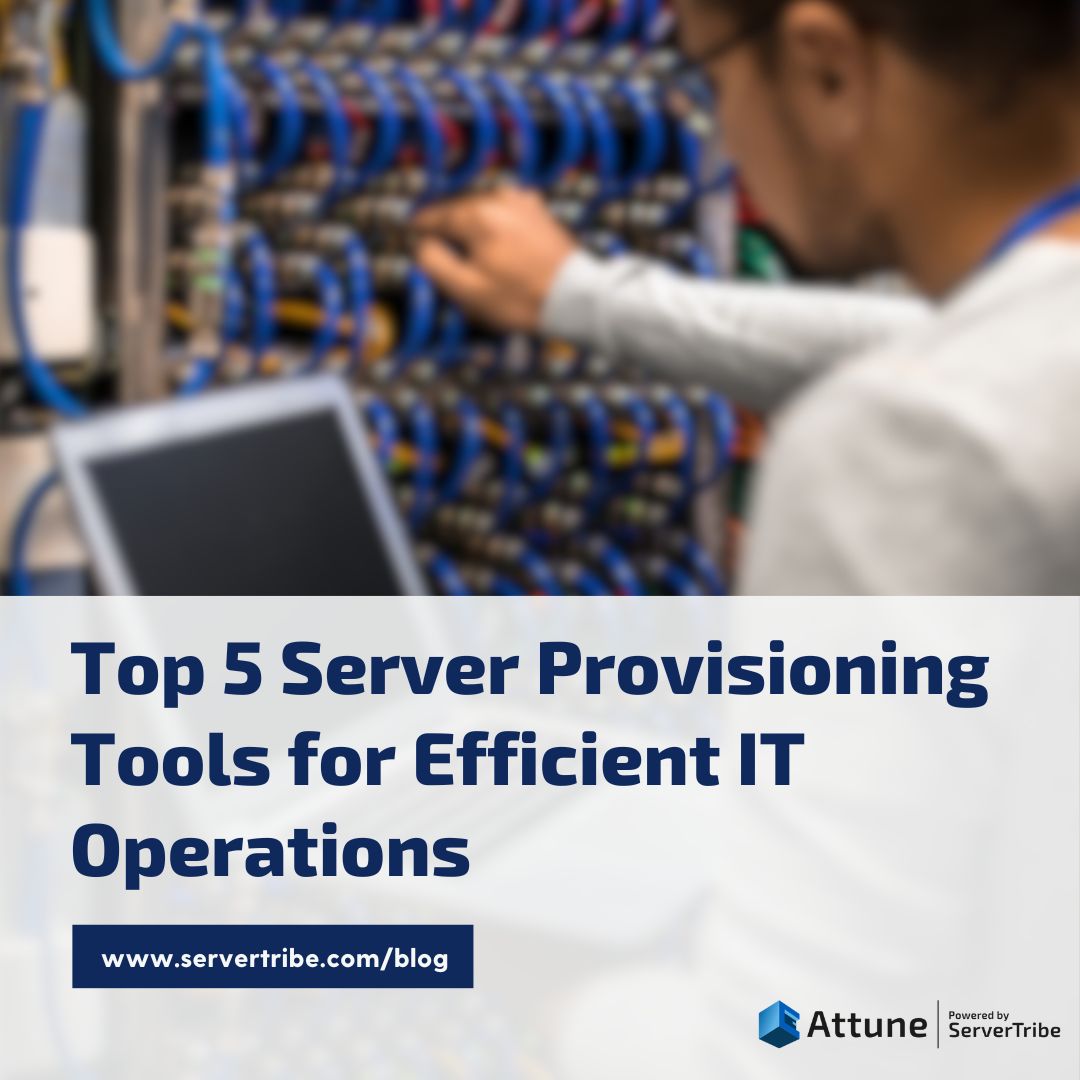
Top 5 Server Provisioning Tools for Efficient IT Operations
In today’s technological environment, Server provisioning tools are critical for maintaining and deploying apps. It’s similar to setting up a stage for a performance where everything needs to be perfect. It involves equipping the servers with the required software, settings, and resources before they can perform their functions properly.
However, doing this all by hand is like putting together a gigantic puzzle. It takes time, and it is easy to make errors. That is why we have specialised tools to help us. These tools are like magical support that can do the task faster and with fewer mistakes.
In this post, we’ll introduce you to the top 5 server provisioning tools that every system admin must use. These tools are well-known for their high efficiency and ease of server setup and administration.
But before we introduce you to the tools, let’s first understand server provisioning and the role it plays in IT infrastructure.

Understanding Server Provisioning
In IT and infrastructure management, server provisioning is a primary topic. It refers to the act of preparing and configuring a server so that it can carry out specified tasks or run specific software applications. Imagine it similar to setting up a workstation but on a bigger scale.
The procedure includes installing and configuring the appropriate operating system, software, and resources like CPU, memory, and storage, all customised to fit the specific needs of a particular activity or application. Proper server configuration ensures that the server is optimised for its intended job, whether that duty is hosting a website, managing databases, or doing sophisticated calculations.
Traditionally, server provisioning was carried out manually, which took a long time and effort. These operations, however, have become simplified, automated, and very efficient with the introduction of modern provisioning technologies.
The Role of Server Provisioning Tools
Server provisioning tools are the reason behind the scenes in today’s frantic IT industry, where being quick, adaptable, and dependable is critical. They serve as the firm basis of a well-built house, ensuring that everything operates correctly. So, let’s look at how these tools serve several functions to make modern IT run successfully.
- Automation and Efficiency
Server provisioning tools simplify the time-consuming and frequently demanding process of setting up and configuring servers. They replace error-prone operations with simplified automated workflows. This not only saves time but also reduces the possibility of human mistakes, resulting in consistent and dependable server installations.
- Flexibility
As a company grows, so does the demand for extra server resources. Server provisioning solutions enable the deployment of new servers on call, which aids in the rapid scalability of infrastructure. This scalability guarantees that IT resources can keep up with shifting demands without experiencing downtime or service disruptions.
- Configuration Management
Server provisioning tools often include powerful configuration management capabilities. IT teams may use them to establish and enforce server settings, ensuring that servers satisfy security and compliance criteria. This consistency is critical for keeping an IT system secure and compliant.
- Integration Capabilities
A wide range of technologies and systems are used in effective IT settings. These tools often integrate with other DevOps and IT management tools, resulting in a unified and integrated environment that streamlines operations and boosts productivity.
- Resource Optimisation
A prime factor in server provisioning is the effective distribution of resources. These technologies help in optimising server resources such as CPU, memory, and storage, ensuring they are fully used. This not only boosts performance but also lowers operational expenses by reducing waste.
- Hardware Abstraction
These tools reflect the underlying hardware, allowing for smooth deployment across diverse server setups. This flexibility is essential in dynamic contexts where server hardware specs may alter.
- Version Control
Managing diverse software versions and configurations across servers may be difficult. Version control features are provided by server provisioning tools, allowing businesses to monitor changes, roll back to earlier configurations, and keep a history of server states. It is effective for troubleshooting and auditing.
Top 5 Server Provisioning Tools
So far, you must’ve understood what server provisioning is and what role its tools play in IT infrastructure.
Now, let’s check out the top 5 server provisioning tools that will make your job easier.
Attune
Let’s start with the top most used tool, which is Attune. It is a significant changer in server provisioning, particularly when it comes to automating physical infrastructure. It provides a comprehensive framework for accurate and agile server provisioning automation in on-premise, data center, and remote site scenarios. Attune enables SysOps teams to automate physical machine deployment and administration by leveraging scripting languages, drastically decreasing human mistakes and improving operational efficiency.

Key Features:
- Automated supply of physical infrastructure
- Support for a wide range of hardware components
- Step-by-step precise documentation using a centralised administration interface
- Dynamic provisioning based on preset criteria
Puppet
Puppet is yet another popular server provisioning solution that excels in configuration management and automation. This tool defines and enforces settings throughout your server infrastructure using a declarative language, assuring consistency and stability.
Key Features:
- For configuration management, Puppet uses its domain-specific language (DSL), which provides a robust and flexible mechanism to specify server states.
- You may use a repository of pre-built modules to access a multitude of community-contributed settings.
- Puppet is extremely scalable, making it ideal for managing big server fleets in business settings.
Ansible
Ansible has grown in popularity as a secure and adaptable server setup tool. It is an open-source automation software created by Red Hat that allows you to design and manage server settings like code. Ansible describes configurations using YAML, a declarative language that is simple to comprehend and manage.
Key Features:
- Ansible does not need the installation of any agents or other software on target servers, minimising costs and simplifying management.
- Users may describe the intended state of servers and automate the provisioning process by creating playbooks.
- Ansible has a large and active user base, which has resulted in rich documentation, modules, and support.
Chef
Chef is an advanced configuration management program that automates the provisioning and maintenance of servers. Configurations are defined using a Ruby-based DSL (Domain-Specific Language). Chef takes a “model-driven” approach to server setup, enforcing desirable settings and ensuring consistency throughout the server environment.
Key Features
- Chef Infra, the fundamental component, is in charge of designing and managing server configurations.
- Chef Habitat makes application packaging and deployment easier, which improves the provisioning process.
- It offers a web-based dashboard allowing you to see and report on your server provisioning and configuration management actions.
Terraform
HashiCorp’s Terraform is a one-of-a-kind server provisioning solution noted for its infrastructure as a code approach. Terraform in contrast to the previously listed technologies, focuses on designing and maintaining the complete infrastructure stack, including servers, networks, and storage.
Key Features
- Terraform defines infrastructure components using a declarative syntax, making it simple to learn and version control.
- Terraform offers a diverse set of providers, allowing you to supply resources across many cloud platforms and on-premises settings.
- The tool plans and applied methodology guarantee that changes are previewed before being executed, lowering the chance of unforeseen effects.
Summing Up
Lastly, these server provisioning tools have changed the way businesses manage their IT infrastructure. These technologies enable firms to respond quickly to changing needs and maintain a competitive edge in today’s dynamic IT world by automating deployment procedures, maximising resource use, and maintaining consistency. Adopting these technologies is a deliberate move toward greater efficiency, scalability, and operational excellence.
Server Provisioning Tools: Frequently Asked Questions
Which tool helps in provisioning?
Depending on the objectives and environment, a range of tools are available to help in provisioning. Here are a few popular ones:
- Configuration Management Tools: Ansible, Puppet, Chef, and SaltStack are popular options for providing and managing server settings. They automate the installation process and configuring servers, ensuring consistency and scalability.
- Infrastructure as Code (IaC) tools: Terraform and AWS CloudFormation are two tools that allow you to use code to supply infrastructure resources (such as servers, networks, and storage). They let users describe infrastructure settings declaratively, making it easier to provide and manage resources programmatically.
- Virtualisation Platforms: Virtualisation platforms such as VMware vSphere, Microsoft Hyper-V, and KVM have built-in tools for provisioning and managing virtualised systems.
- Cloud Service Providers: Amazon Web Services (AWS), Microsoft Azure, and Google Cloud Platform (GCP) provide native tools and APIs for deploying cloud resources such as virtual machines, containers, databases, and more.
The kind of infrastructure, deployment environment (on-premises or cloud), scalability needs, and organisational preferences all influence the tool selection process.
How do I automate server provisioning?
Server provisioning may be automated through the use of tools, scripts, and procedures to automatically set up and configure servers.
Here’s an overview of how to automate server provisioning.
- Choose software that automatically configures servers. Popular solutions include Ansible, Puppet, and cloud-based platforms like AWS or Azure.
- Create simple files or scripts that describe how each server should be configured. These files specify what the automation tool should do, such as install software or adjust permissions.
- Organise playbooks or plans that provide the servers’ configuration to the automation tool. These strategies ensure that everything happens in the correct order.
- Set up servers with your automation. Make sure it works as expected in a safe test environment.
- Once everything is operational, include server setup automation into your usual routine. In other words, all it takes is a few clicks or keystrokes to start up a new server every time you need one.
- Monitor your automatic setup to ensure it is working well. Resolve any issues and update your configuration as necessary.
You can reduce manual work, speed server provisioning, and guarantee dependable and consistent deployments throughout your infrastructure by following these procedures and utilising automation technologies.
What are the uses of provisioning?
Provisioning provides several critical functions in IT infrastructure management:
- Resource Allocation: Provisioning is the process of allocating computer resources as servers, storage, and networking components to an organisation’s various workloads, applications, and services.
- Configuration Management: Provisioning guarantees that assigned resources are properly configured with the necessary settings, software, and security measures to match the workload or application’s unique requirements.
- Scalability: Provisioning lets businesses rapidly scale their infrastructure up or down in response to changing needs, such as increasing user traffic or workload growth.
- Consistency: Automated provisioning guarantees that resources are provisioned consistently across environments, lowering the risk of configuration mistakes and maintaining uniform system setups.
- Efficiency: By automating the provisioning process, organisations may eliminate manual work, shorten deployment times, and increase operational efficiency. This helps IT teams to prioritise higher-value work and innovation over repeated provisioning operations.
Provisioning, in general, is essential for maximising resource use, preserving system dependability, and promoting the scalability and flexibility of contemporary IT settings.

Comments